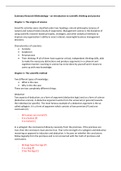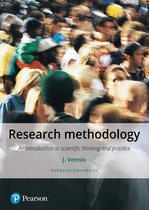Summary Research Methodology – an introduction to scientific thinking and practice
Chapter 1. The origins of science
Scientific activities were classified under two headings: natural philosophy (science of
nature) and natural history (study of organisms). Management science is the discipline of
using scientific research-based principles, strategies, and other analytical methods to
improve any organization’s ability to enact rational, meaningful business management
decisions.
Characteristics of scientists:
• Curiosity
• Scepticism
• Perseverance
• Their thinking à all of them have superior critical, independent thinking skills, able
to make the necessary distinctions and produce arguments in a coherent and
cognitive manner. Learning in science has to be done by yourself and it means to
come up with new knowledge.
Chapter 2. The scientific method
Two different types of knowledge:
• What is the case
• Why is this the case
These are two completely different things.
Deduction
Two aspects of deduction; as a form of argument (deductive logic) and as a form of science
(deductive science). A deductive argument works from the universal (or general) towards
the individual (or specific). The most famous example of a deductive argument is the so-
called syllogism. It is a form of argument which consists of two premises (P) and one
conclusion (C).
- All humans are mortal (P)
- X is a human (P)
- X is mortal (C)
In a syllogism the conclusions follow by necessity from the premises. If the premises are
true, then the conclusion must also be true. That is the strength of a syllogism and deductive
reasoning as opposed to induction and abduction. Is focuses on whether the conclusions
follow logically from the premises and is not concerned with the truth of premises and
conclusions.
- All dogs have five legs (P)
- X is a dog (P)
- X has five legs (C)
,This is an example of a valid argument; however, the conclusion is not true. Hence, the truth
of the conclusion depends heavily on the truth of the premises; these should correspond to
a state of affairs in reality. A sharp distinction between a valid argument and a true
conclusion has to be made. The term validity – when used in the context of formal logic –
refers to the logical correctness of an argument. But as stated, correspondence with reality
is not the topic of formal logic. Formal logic is only concerned with the correctness of an
argument. Apart from a deductive argument another important form of argument is the
‘material implication’. It has the following conditional form:
P implies q à If p then q.
Four different situations can occur. Either p holds or not, and the same can be said for q.
a) P is true:
a. If p then q;
b. P holds;
c. Therefore q.
Whatever one substitutes for p and q, the argument will always be valid. This
situation is called ‘modus ponens’ (mode that affirms), if p holds then q must also
be the case.
- When it rains the streets get wet;
- It rains;
- The streets get wet.
b) P does not hold:
a. If p then q;
b. Not p;
c. Therefore not q.
This is a fallacious argument knows as: denying the antecedent. If it has not been
raining is does not follow that the streets will not be wet, they could be wet due
to some other factor.
c) When q holds:
a. If p then q;
b. Q holds;
c. Therefore p.
This is a fallacious argument known as: affirming the consequent. In both cases
the fallaciousness is caused by the fact that p is considered to be a necessary
condition, rather than a sufficient one. After all is does not have to rain for the
streets to get wet, and if the streets are wet there are other potential causes for
it than rain.
d) Q does not hold:
a. If p then q;
b. Not q;
c. Therefore not p.
This type is called ‘modus tollens’ (mode that denies). This again is a valid form of
argument, as is the modus ponens.
, - When it rains the streets get wet;
- The streets are dry;
- It does not rain.
Deduction as a way of thinking plays an important role in almost every branch of science,
but there are not many branches in science which are completely deductive. Deductive
sciences do not take empirical phenomena as their point of departure, but rather start from
particular axioms (or postulates), which are considered more or less evident: they do not
need a certain proof to be accepted as true.
Induction
Induction can be seen as a form of argument (inductive logic) but also as a way of
conducting science (inductive science). In methodological terms induction means going from
the specific to the general, from observing a set of empirical phenomena to a general
statement, quite the opposite from deduction. Induction is not specific for science, we use it
(mostly unconsciously) frequently in everyday life. Induction does not lead to general
statements of which we can be certain. Two forms of induction:
• Complete induction:
o All x have been studied
o All studied x have characteristic y
o Conclusion: all x have characteristic y
• Incomplete induction:
o I have seen a number a trees
o All those trees have green leaves
o Conclusion: all tress gave green leaves
In this sense, new knowledge is added, but the downside is that we cannot be sure
that the conclusion is true. This is known as the induction problem.
The inductive strategy of knowledge acquisition consists of the following steps:
a) All facts are observed and recorded without selection or guesses as to their relative
importance
b) These facts are analyzed, compared and classified, without using hypotheses
c) From this analysis, generalizations are inductively drawn as to the relations between
them
d) These generalizations are subjected to further testing
All sciences, which take empirical reality, i.e., empirical phenomena as they appear to us, as
their point of departure, are inductive sciences. While a deductive science relies very heavily
on logic and argument to build the body of knowledge from the axioms, inductive sciences
rely heavily on observation of empirical phenomena. And while observing, the researcher
attempts to find patterns or regularities. The whole idea is that through observation of
particular empirical phenomena, one tries to find regularities, or recurring patterns. Finding
patterns is also the case in other than the natural sciences. It also plays a role in the social
sciences.
Induction, as a method to arrive at certain knowledge, has several problems. The first is the
induction problem (already discussed). The second is the so-called frank or unprejudiced
, observation. Human observation is influences in all sorts of (unconscious) ways. The third
problem is the misunderstanding that through induction hypotheses to explain the
phenomena will more or less automatically surface. Coming up with explanations for what
you have observed, requires some deep reflection, and creativity.
Abduction
Induction and deduction differ in the ways to acquire knowledge. Apart from these two
types of argument, Aristotle distinguished a third form of argument, i.e. retroduction or
reduction. This latter form has long been neglected in science and philosophy. According to
Pierce in a deductive argument the conclusions follow logically from the premises. In that
sense deduction does not give rise to new knowledge: the conclusion is enclosed in the
premises. In Pierce’s opinion it is only incomplete induction and abduction which create
(potential) new knowledge.
Abduction means creating a hypothesis which can explain an empirical phenomenon. It is
also known as ‘the method of hypothesis’ or ‘inference to the best explanation’. Kepler came
up with potential hypotheses (in this case also called models) which could describe and
explain the observed motions of the planets.
The work of Copernicus is often referred to as the Copernican Revolution, because he more
or less turned the view of the universe upside down. Copernicus also assumed that the
planets moved in circles, but the big difference with Ptolemy’s model is that it is a
heliocentric model, meaning that the sun in at the centre, and the earth makes two kinds of
movements: it rotates on its own axis, but is also revolves around the sun. If we have two
explanations for the same phenomenon, we should always choose the simpler of the two,
because simpler solutions are more likely to be correct.
Smith formulates the law of supply and demand, and how these two affect the price, which
in turn influence demand and supply. The important thing to remember is that Adam Smith
perceives a situation which is puzzling. If there is no coordination in terms of tradition or an
authoritarian rule why does society not disintegrate? And since it did not, how could that be
explained? A clear case of abduction, finding a hypothesis (the law of supply and demand),
which explains the puzzle. This also goes to show that induction itself will not generate such
a hypothesis directly.
Groupthink refers to a mode of thinking that people engage in when they are deeply
involved in a cohesive in-group, when the members’ strivings for unanimity override their
motivation to realistically appraise alternative courses of action. Groupthink is a situation in
a group in which loyalty requires each member to avoid raising controversial issues.
Deduction, induction, and abduction are quite distinct ways of acquiring knowledge, but in a
way, abduction differs considerably from both induction and deduction. And that is with
regard to the distinction between what is called the ‘context of discovery’ and the ‘context
of justification’. Context of discovery refers to the situation in which ideas and hypotheses
are generated, which should explain certain phenomena. The context of justification refers
to the situation in which ideas, hypotheses, theories are tested against logic and/or
empirical evidence. Much of the philosophy of science is focused on the latter, on the





